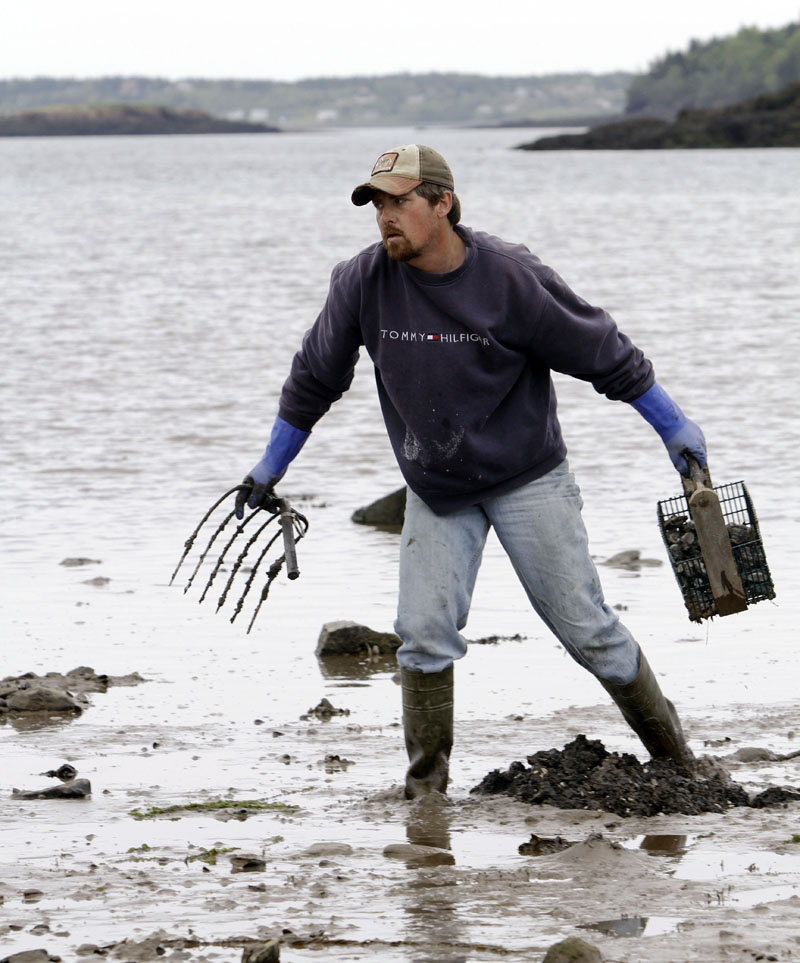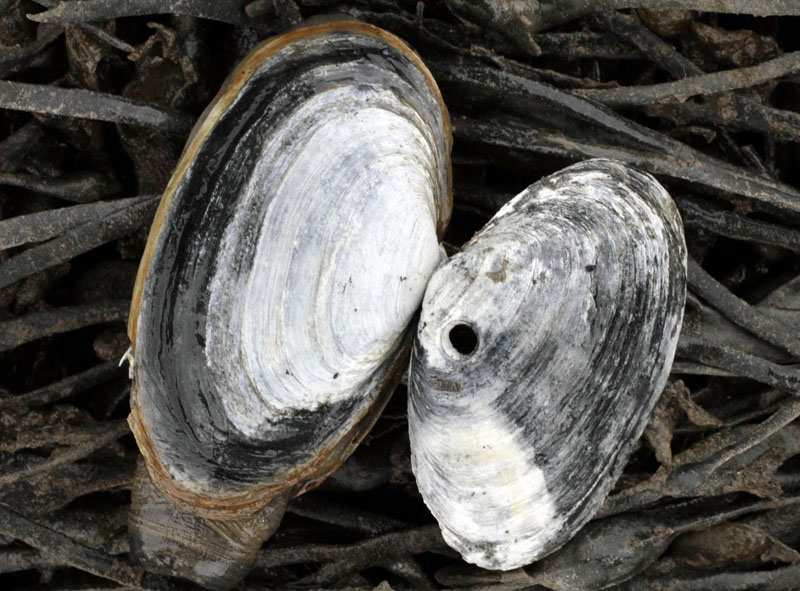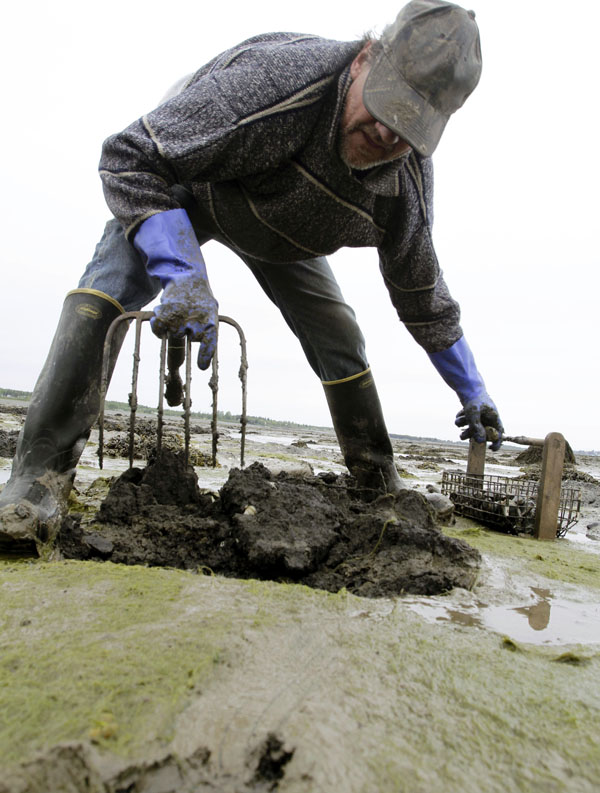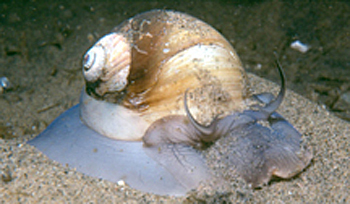LUBEC — Out on the mud flats in the easternmost nook of the United States, generations of clam diggers have dug deep into the muck for tasty soft-shells to satisfy New Englanders’ cravings for steamers and fried clams.
These days, the digging isn’t so good. The clam harvest in far eastern Maine has dropped sharply in recent years, and clam diggers say one big reason is an onslaught of the carnivorous moon snail.
The little-known mollusk that drills into clams and other shellfish and eats the meat inside has been multiplying. The besieged clam population has fallen, leaving diggers with fewer clams for the taking.
The snail sounds almost unreal: Mucous-oozing creatures emerging from the mud in the dark of night, drilling their way into unsuspecting clams with sandpaper-like tongues and leaving behind empty shells.
“It’s like science fiction,” said Brian Beal, a marine ecology professor at the University of Maine-Machias who’s studied clams and snails for decades.
Clam diggers aren’t happy.
For 30 years, Bob Varney, 55, has earned an honest day’s pay on Lubec’s flats by pulling his four-pronged clam rake over and over through the mud, clay and sand in search of the sweet “piss clams,” so named because they squirt water through their necks at clammers walking by. The work is difficult and dirty, bringing barely $50 a day.
These days, Varney typically harvests 55 to 60 pounds in four or five hours. Not long ago, he could rake up double that, but the clams are spread thin nowadays. A growing number have deadly drill holes in their shells from the moon snails.
What concerns him most are the snails’ volcano-shaped egg cases – some of which can hold more than 1 million eggs – that show up nearly everywhere he digs.
“We didn’t have anything like this even two or three years ago,” Varney said, taking a break from digging. “They’ve just escalated.”
Moon snails are native to the region, ranging from Canada’s Gulf of St. Lawrence to North Carolina. In Maine, their numbers go in cycles from area to area; biologists say there was a surge in the 1970s and ’80s.
For now, there’s no concern that the creatures will spread in abundance beyond far eastern Maine, one of the most productive clamming areas in Maine and New England. Thirty miles away, clam diggers don’t even have an inkling about the snails, Beal said.
Some cultures consider the snails a delicacy, but in Maine they’re just a nuisance. Beal said they may be more numerous in eastern Maine because of the decline of green crabs, which prey upon the snails and clams.
That’s bad news in a region where jobs are scarce and many make their livelihood from the land and the sea.
Some clammers work on fishing boats, rake blueberries and make Christmas wreaths. They cut wood and pick periwinkles – a snail-harvesting practice known as “wrinkling” – off the rocky ocean ledges. Many dig clams, which make their way to stores and restaurants across New England and the Northeast.
Clam harvests fluctuate, but the downturn has been severe in Cobscook Bay, a sprawling body of ocean water tucked against the Canadian border, known for its 20-foot tides, turbulent waters and rich ecosystem. The harvest in Lubec and other bay towns fell by 85 percent from 2006 to 2009 – from about 800,000 pounds to about 100,000 – according to the Maine Department of Marine Resources.
Partly to blame for the decline are widespread outbreaks of “red tide,” caused by a naturally occurring algae that produces a toxin that makes clam harvesting off limits, Beal said. But the rise of moon snails is the No. 1 reason.
On a recent day on a Lubec flat, Beal and some clammers found dozens and dozens of the snails and their small egg cases, which look like small pieces of rubber littered on the mud.
Harmless-looking and slow-moving, the creatures can turn deadly when they get hold of a clam under the mud, enveloping it with its slimy, mucous-oozing foot and softening the shell with an enzyme secretion. In just a day, they can drill a hole in the softened shell and eat the clam meat inside.
“They just go in and slurp it up,” Beal said.
On the flats, clammers in their rubber boots have a hard enough time of it without the snail invasion. They work in the wet and cold, sometimes sinking knee-deep into Jello-like mud pockets known as “honey pots” that can suck their legs down in a flash, trapping them until they can wiggle free, sometimes leaving a boot behind.
Lately, diggers have been getting less than $1 a pound (prices will probably be double that in August, when demand is highest).
In Lubec, a town of 1,500, the value of the harvest has fallen from $566,000 four years ago to just $39,000 last year, according to the state.
David Case, 34, said it’s barely worth his while to dig clams these days. But there’s little else around to make a buck, and he still has to put food on the table.
“I always said I wouldn’t dig clams for under $1 a pound,” he said. “But if you don’t have any money, what can you do?”
Dennis Huckins, 56, said the moon snail is a crook, taking money out of clam diggers’ wallets.
“It’s a thief,” he said. “It steals from you.”
But many diggers keep at it because there’s nowhere else to turn. Back in the day, Lubec was a bustling place with seafood processing plants, a busy downtown – even a movie theater.
“There’s nothing substantial here you can do,” Huckins said. “How many Walmarts and McDonald’s do you see? There’s not a lot of industry here. You make your own.”
For now, clam diggers have been removing snail egg cases — more than 90,000 so far — from the flats. Beal records their findings and the diggers usually dump the snails on their gardens as fertilizer.
Some people think the moon snails could be processed, packaged and sold.
“There’s a market for moon snails somewhere in the world,” Beal said. “Why not market ours?”
Send questions/comments to the editors.






Success. Please wait for the page to reload. If the page does not reload within 5 seconds, please refresh the page.
Enter your email and password to access comments.
Hi, to comment on stories you must . This profile is in addition to your subscription and website login.
Already have a commenting profile? .
Invalid username/password.
Please check your email to confirm and complete your registration.
Only subscribers are eligible to post comments. Please subscribe or login first for digital access. Here’s why.
Use the form below to reset your password. When you've submitted your account email, we will send an email with a reset code.